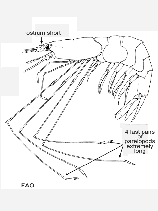Nematocarcinus africanus Crosnier & Forest, 1973
African spider shrimp| Native range | All suitable habitat | Point map | Year 2050 |

|
| This map was computer-generated and has not yet been reviewed. |
| Nematocarcinus africanus AquaMaps Data sources: GBIF OBIS |
Classification / Names Common names | Synonyms | CoL | ITIS | WoRMS
Malacostraca | Decapoda | Nematocarcinidae
Environment: milieu / climate zone / depth range / distribution range Ecology
Benthic; depth range 200 - 755 m (Ref. 434), usually 300 - 600 m (Ref. 434). Tropical; 5°C - 12°C (Ref. 434); 16°N - 20°S, 18°W - 14°E
Distribution Countries | FAO areas | Ecosystems | Occurrences | Introductions
Eastern Atlantic: from Senegal to Namibia.
Length at first maturity / Size / Weight / Age
Maturity: Lm ? range ? - ? cm Max length : 10.4 cm TL male/unsexed; (Ref. 434)
Maximum depth from Ref. 104448. Exclusively occurs in deep-sea, living in soft mud deep sea bottom (Ref. 98500). Predominantly benthic species inhabiting only muddy bottoms in cold waters (5-12°C). Vertical distribution varies in size, older individuals occur in deeper depth range from 200 to 700 m, most abundant between 300 and 600 m (Ref. 434). Key functional intermediate between decaying organic matter and larger invertebrates and fish (Ref. 107108).
Life cycle and mating behavior Maturity | Reproduction | Spawning | Eggs | Fecundity | Larvae
Members of the order Decapoda are mostly gonochoric. Mating behavior: Precopulatory courtship ritual is common (through olfactory and tactile cues); usually indirect sperm transfer.
Main reference
References | Coordinator | Collaborators
Fischer, W., G. Bianchi and W.B. Scott (eds.). 1981. (Ref. 434)
IUCN Red List Status (Ref. 130435)
CITES status (Ref. 108899)
Not Evaluated
CMS (Ref. 116361)
Not Evaluated
Threat to humans
Human uses
Fisheries: commercial
| FishSource |
Tools
More information
Internet sources
BHL | BOLD Systems | CISTI | DiscoverLife | FAO(Publication : search) | Fishipedia | GenBank (genome, nucleotide) | GloBI | Gomexsi | Google Books | Google Scholar | Google | PubMed | Tree of Life | Wikipedia (Go, Search) | Zoological Record
Estimates based on models
Preferred temperature
(Ref. 115969): 6.3 - 11, mean 8.8 (based on 29 cells).
Price category
(Ref. 80766):
Unknown.



